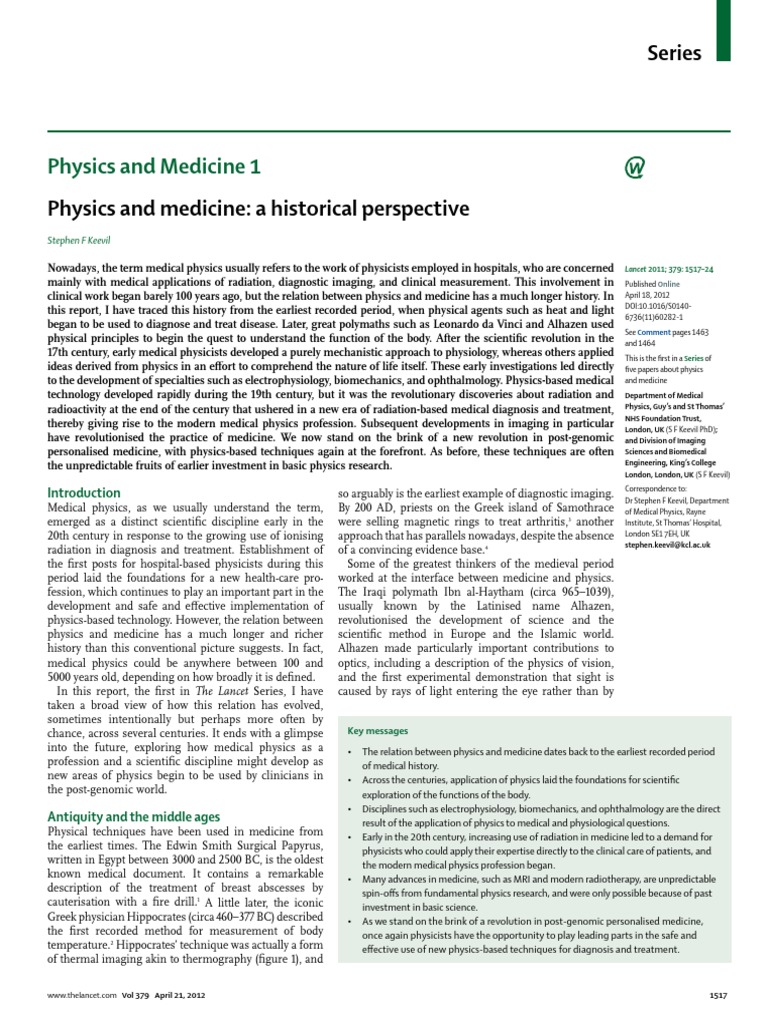Physics and medicine, two seemingly distinct disciplines, share an intricate and multifaceted relationship that has evolved over centuries. This interplay manifests through various applications, from diagnostic tools to therapeutic interventions, all grounded in fundamental physical principles. The admiration for this intricate relationship may stem from the profound impact that a deeper understanding of physics can have on medical advancements. By exploring this connection, we delve into the historical context, the current applications, and the future possibilities of integrating physics within the medical realm.
The historical intersection of physics and medicine can be traced back to key figures whose innovative thinking reshaped both fields. For example, in the late 19th century, Wilhelm Röntgen’s discovery of X-rays revolutionized diagnostic imaging. This serendipitous event illustrated how principles of electromagnetism could unveil the hidden structures of the human body. Such a breakthrough did not merely enhance imaging techniques; it laid the groundwork for a series of advancements that would intertwine clinical practice with physical sciences.
In contemporary medicine, the evidence of physics’ influence is palpable through numerous diagnostic tools. For instance, Magnetic Resonance Imaging (MRI) utilizes the principles of nuclear magnetic resonance, a phenomenon deeply rooted in quantum mechanics. The ability to visualize soft tissues in high detail has fundamentally altered the diagnosis and monitoring of various medical conditions, from neurological disorders to tumors. Understanding these imaging modalities requires a grasp of the underlying physical principles that govern their operation, underscoring the essential interplay between physics and medicine.
Moreover, the technological advancements stemming from physics extend beyond diagnostics. Radiation therapy is another salient example, illustrating how physics directly contributes to treatment methodologies. By harnessing ionizing radiation, healthcare professionals can target and destroy malignant cells while sparing surrounding healthy tissues. The delicate balance between maximizing therapeutic outcomes and minimizing damage hinges on an in-depth understanding of dosimetry, the study of the treatment’s radiation dose distribution. Such precision is crucial and exemplifies the necessity for medical practitioners to collaborate with physicists, thus cultivating an interdisciplinary approach that paves the way for more effective treatments.
As we navigate the continuum of care for patients, the integration of physics into medical processes becomes increasingly apparent. The burgeoning field of biophysics illustrates this synthesis explicitly. Structure-function relationships of biomolecules, molecular dynamics simulations, and the interactions between electromagnetic fields and biological tissues reflect the significant contributions of physics to understanding health at a molecular level. Furthermore, advancements in drug delivery systems, including nanoparticle technologies that exploit physical principles to enhance target specificity, demonstrate how innovative applications can emerge from the confluence of these two disciplines.
The impact of physics in medicine extends into the realm of telemedicine and health informatics as well. Algorithms rooted in physical models play a vital role in interpreting medical data, enhancing diagnostic accuracy, and facilitating remote care. Machine learning and artificial intelligence—fields that have seen monumental growth driven by physical computing processes—now assist healthcare professionals in identifying patterns that might elude the human eye. Such technologies not only optimize patient outcomes but also suggest new avenues for research and application, blurring the lines of traditional medical practices.
Moreover, the future of medicine stands poised to be transformed by the continued infusion of physics concepts. The rise of personalized medicine epitomizes this trajectory, where treatments are tailored to individual physiological and genetic profiles. This approach necessitates a profound understanding of biophysics, systems biology, and the physical forces at play within the human body. Researchers are increasingly looking to apply physical models to predict responses to therapies, thus enhancing the precision and efficacy of medical interventions.
Additionally, as the field of medical imaging continues to evolve, emerging methodologies promise to further bridge the chasm between physics and medicine. Techniques such as positron emission tomography (PET), single-photon emission computed tomography (SPECT), and the use of advanced optical imaging underscore ongoing innovations. These technologies derive their efficacy from complex physical interactions, necessitating an intimate knowledge of both medical requirements and fundamental physics principles. The continuous refinement of these technologies will likely lead to even more revolutionary breakthroughs in patient care.
Furthermore, nanotechnology presents another frontier where physics holds transformative potential for medicine. Nanoscale materials exhibit unique physical properties that can be harnessed for various applications, including drug delivery, imaging, and diagnostics. This burgeoning field highlights the necessity for collaborative research that marries physics with biology and medicine, enabling the development of sophisticated solutions to complex medical challenges.
In conclusion, the relationship between physics and medicine is a captivating exploration of how the principles governing the natural world can unveil new horizons in health and healing. The union of these disciplines fosters innovation and enhances our understanding of biological systems, ultimately leading to better patient outcomes. As advances continue, the necessity for interdisciplinary collaboration will only intensify, promising a future where the principles of physics will play an even more pivotal role in reshaping the landscape of modern medicine.












